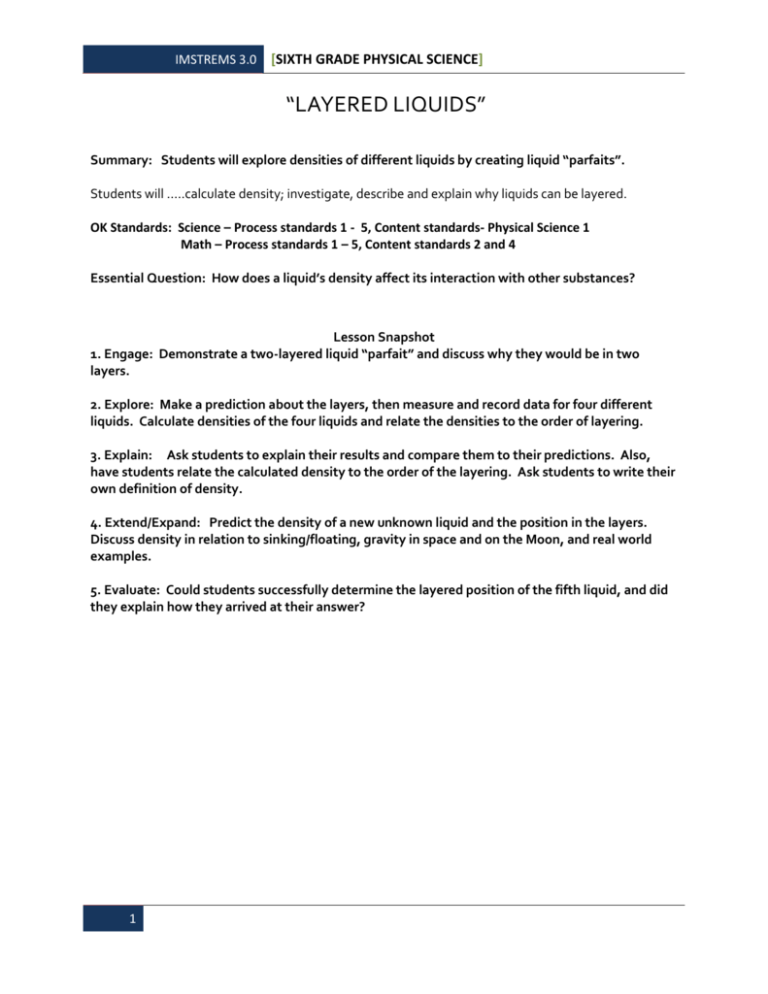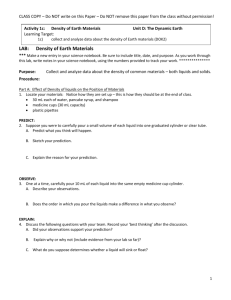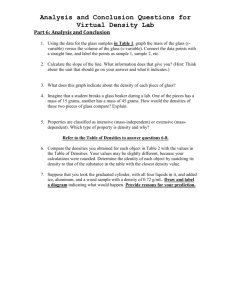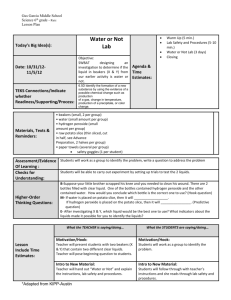5 E Lesson Plan Liquid Layers
advertisement

IMSTREMS 3.0 [SIXTH GRADE PHYSICAL SCIENCE] “LAYERED LIQUIDS” Summary: Students will explore densities of different liquids by creating liquid “parfaits”. Students will …..calculate density; investigate, describe and explain why liquids can be layered. OK Standards: Science – Process standards 1 - 5, Content standards- Physical Science 1 Math – Process standards 1 – 5, Content standards 2 and 4 Essential Question: How does a liquid’s density affect its interaction with other substances? Lesson Snapshot 1. Engage: Demonstrate a two-layered liquid “parfait” and discuss why they would be in two layers. 2. Explore: Make a prediction about the layers, then measure and record data for four different liquids. Calculate densities of the four liquids and relate the densities to the order of layering. 3. Explain: Ask students to explain their results and compare them to their predictions. Also, have students relate the calculated density to the order of the layering. Ask students to write their own definition of density. 4. Extend/Expand: Predict the density of a new unknown liquid and the position in the layers. Discuss density in relation to sinking/floating, gravity in space and on the Moon, and real world examples. 5. Evaluate: Could students successfully determine the layered position of the fifth liquid, and did they explain how they arrived at their answer? 1 IMSTREMS 3.0 [SIXTH GRADE PHYSICAL SCIENCE] Lesson Preparation or Notes to Teacher: This lesson is an edited version of the “Liquid Layers” activity from Activities Linking Science with Math 5-8, with additional information and pictures from Steve Spangler Science and Summer Fields Science (listed in “Resources”). Student worksheets with data tables are included at the end of the lesson. Food coloring may be added to liquids to have a more colorful “parfait” and to give greater distinction between the layers. Materials: Water Food Coloring Corn Syrup Tall, clear, plastic containers (clear plastic cups or empty water bottles, approximately 500 ml capacity are just right) Beakers or graduated cylinders for measuring liquids Paper Cups Balances Calculators Maple syrup Vegetable oil Dishwashing detergent Mineral oil Lesson Procedures: Engage: Begin by demonstrating two-layer liquid “parfait” using water and corn syrup. (It will be more evident if you add food coloring to the water.) Model pouring carefully over a spoon so students understand how to do this correctly. Ask students why the liquids formed two layers, accepting all possibilities. Use their answers to guide them toward density. There is also a good video on Steve Spangler Science. Explore: 1. Put students in small groups, have students measure out 100 ml of each of the four liquids (water, syrup, vegetable oil, and dishwashing liquid). Liquids must be poured into identical containers because their masses will be compared. Students must record data in a data table. 2. Students should predict the order of the layers of the four liquids, and record their predictions in their data table. 3. Next, students should measure the mass of each liquid container, and record the masses in their data table. (Students should first measure the mass of an empty container so it can be subtracted to determine the mass of the liquid alone.) 4. Students will calculate the density of each liquid using the formula D = m/V. (The volume for each should be 100 ml.) Students should record the densities in their data table. 5. Students will make another prediction about the order of the layers based upon the density calculations. Students should record these predictions and answer the question, “Did your prediction change? Why or why not?” 2 IMSTREMS 3.0 [SIXTH GRADE PHYSICAL SCIENCE] 6. Students will carefully pour their four liquids into a single tall, clear container using a spoon so that they do not mix. Students should record the order of the layers. Explain: Ask students to explain their results and compare them to their predictions. Also, have students relate the calculated density to the order of the layering. Ask students to write their own definition of density. Elaborate (Extend/Expand): 1. Students will receive a fifth liquid sample. Students will measure its mass, calculate its density, and record these values in a data table. They will use the density to predict its position in the liquid “parfait”. 2. Students will pour the fifth liquid into the container holding the four-liquid “parfait” and observe and record the accuracy of their prediction. 3. Have students discuss the following questions within their groups and record their ideas, then have groups share with the class and teacher: a. What does density have to do with sinking and floating? b. If you tried this aboard the space shuttle in outer space, would the results differ, and if so, how? If you tried it on the Moon, would your results be same or not? c. What real-world examples can you think of which involve liquids and density? d. Can you think of any jobs that might involve the concepts of density, sinking and floating? Explain your answers. Evaluate: 1. Were students able to successfully layer the liquid samples? 2. Were students’ predictions for the order of the four liquids (from Explore step 5. above) correct? If so, could the students explain why, or if not, could they explain why not? 3. Were students’ predictions for the fifth liquid correct, and could they explain why? 3 IMSTREMS 3.0 [SIXTH GRADE PHYSICAL SCIENCE] Differentiation: Intentional grouping with mixed ability levels will facilitate learning for lowerachieving students. For more advanced students, a station could be set-up to allow experimentation with placing different small solid objects into a prepared liquid “parfait” to see where they will settle within the layers. Have students write an explanation of their findings. Authentic Strategies Higher Order Thinking Substantive Conversation Deepening Knowledge Connections to Real World Student-Centered Learning- Eight Mathematical Practices: Resources: Eichinger, John. Activities Linking Science with Math 5-8; NSTA Press, 2009, pgs 89 – 97. Steve Spangler Science http://www.stevespanglerscience.com/lab/experiments/density-tower-magic-with-science Summer Fields Science http://sfscience.wordpress.com/2014/03/31/density/ 4 IMSTREMS 3.0 5 [SIXTH GRADE PHYSICAL SCIENCE] IMSTREMS 3.0 6 [SIXTH GRADE PHYSICAL SCIENCE]





